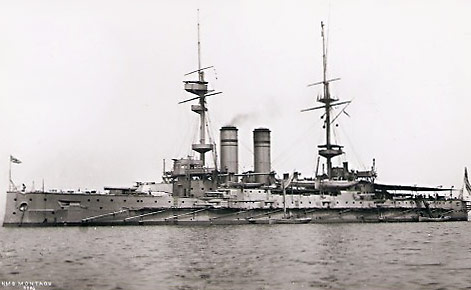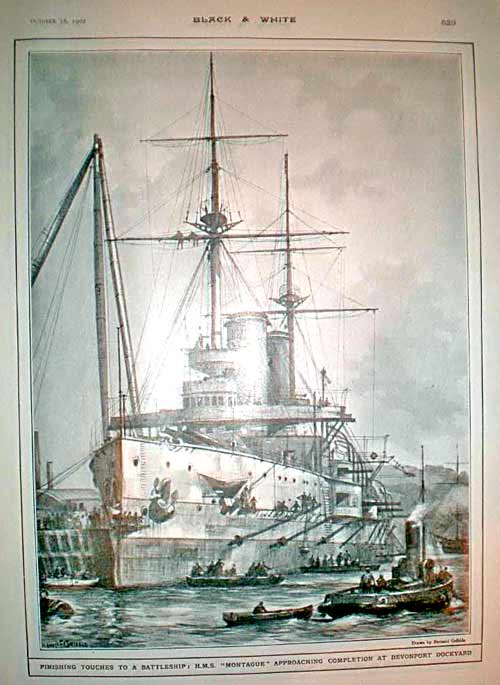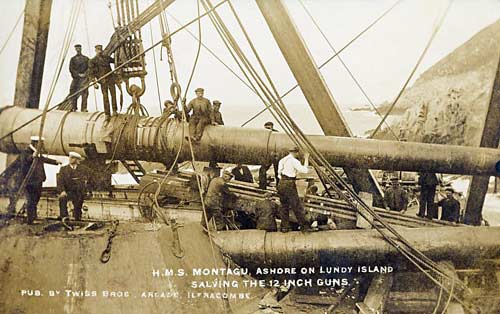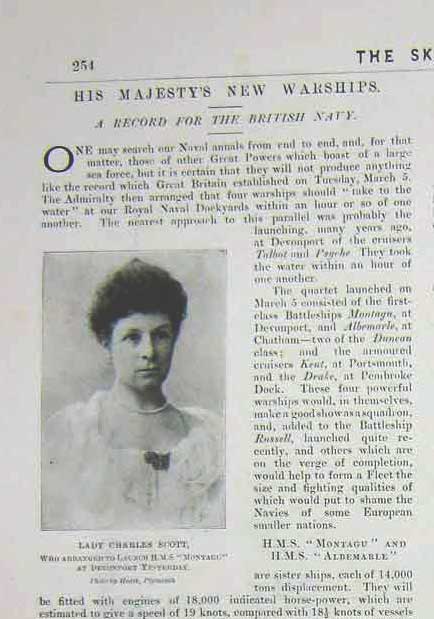HMS Montagu 1901
HMS Montagu was a Duncan-class pre-dreadnought battleship built in Devonport at a cost of
£1,046,992. She was laid down 23 November 1899, launched 5 March 1901 and commissioned on 28 July 1903. [1]
 An early 20th century postcard of HMS Montagu
An early 20th century postcard of HMS Montagu
Montagu was one of five Duncan-class ships of the same period, ordered by the Admiralty to counter the
French and Russian ship-building activities. It was believed, mistakenly in the event, that the
Rusian ships were fast and heavily armed, but the British Duncans outclassed them in both speed and firepower.
 The Montagu in build at Devonport - published in the Black and White Budget magazine, October 1902
The Montagu in build at Devonport - published in the Black and White Budget magazine, October 1902
Unfortunately HMS Montagu survived only three years from commission. Having first
operated in the Mediterranean for two years she then joined the Channel fleet based
at Portland from 1905. In 1906 she was testing wireless equipment in the Bristol
Channel and, in May that year, when thick fog came the decision was made to anchor
off Lundy Island. Instead of anchoring two miles off as planned, Montagu had
travelled into a spot off Lundy called Shutter Point. This proved to be fatal -
she ran hard aground, couldn't be moved, and subsequently became a wreck upon that very spot. Her captain
and navigating officer were held responsible and court-martialled.
As it happened she would have become obsolete anyway, since a new class of battleship was being built at this time, outclassing the Duncans - the Dreadnoughts.
The Montagu Steps
A flight of steps were built to facilitate the salvage of HMS Montagu, they became known as The Montagu Steps. [2]
Salvage continued for many years until 1922 when the wreck broke and sank.
The steps are apparently still there but now in dangerous condition.
 Early postcard showing salvage operations off the Montagu Steps
Early postcard showing salvage operations off the Montagu Steps
Article published in The Sketch 6th March 1901
 Quote
Quote
HIS MAJESTY’S NEW WARSHIPS,
A RECORD FOR THE BRITISH NAVY.
One may search our Naval annals
from end to end, and, for that matter, those of other great powers which boast of
a large sea force, but it is certain that they will not produce anything like the
record which Great ~Britain established on Tuesday, ~March 6. The Admiralty then
arranged that four warships should “take to the water” at our Royal Naval Dockyards
within an hour or so of ne another. The nearest approach to this parallel was probably
the launching, many years ago, at Devonport of the cruisers
Talbot and
Psyche.
The took the water within an hour of one another.
The quartet launched on March 5 consisted of the first-class battleships Montagu,
at Devonport, and Albemarle, at Chatham – two of the Duncan class: and the
armoured cruisers Kent, at Portsmouth, and the Drake at Pembroke Dock.
These four powerful warships would, in themselves, make a good show as a squadron,
and, added to the battleship Russell, launched quite recently, and others
which are on the verge of completion, would help to form a fleet the sixe and fighting
qualities of which would put to shame the Navies of some European smaller nations.
HMS
MONTAGU and HMS
ALBEMARLE
are sister ships, each of 14,000 tons displacement.
They will be fitted with 18,000 indicated horse-power, which are estimated to give
a speed of 19 knots, compared with 18½ knots of vessels of similar dimensions. The
vital parts of these vessels will be protected by a belt of armour of Harveyised
[sic] steel, seven inches in thickness and extending in length of 209 feet, tapering
off to three inches in thickness at the bow and stern. The ships were commenced
at different times, and it is more a matter of coincidence than anything else that
they should have awaited simultaneously the “breaking of the bottle”.
In the construction of a warship, much naturally depends upon the delivery of armour
from private firms, and the testing of every plate, in the rapidity with which she
is got out of hand, for we are not in the habit of swelling our Navy with anything
but that which will withstand the shot and shell of an enemy and which can repay
with interest all that she receives.
HMS
KENT
belongs to a new class of armoured cruiser, her consorts being the
Essex, Monmouth and
Bedford. They are each of 9800 tons displacement,
and will have engines of 22,000 horse-power, capable of giving a speed of23 knots.
The boilers will be of the Niclausse [sic] type, and the principal armament will
consist of fourteen 6-inch quick-firing guns and twelve 12-pounders. A large number
of smaller weapons will be carried. They will be protected by a four-inch armour
belt of Harveyised steel, and the casemates will also have a four-inch armour protections.
The dimensions of the
Kent are: length 440 feet; breadth 66 feet; draught
24½ feet.
Special interest attaches to THE CARRIER
DRAKE, built at Pembroke Dockyard.
She is the largest modern ironclad constructed at the Naval Dockyard, having a displacement
of 14,100 tons. Her engines, of 30,000 indicated horse-power, are estimated to give
a speed of 23 knots. She is named after that gallant Devonshire sea-captain, Sir
Francis Drake, who showed his sterling worth at the time of the Spanish Armada.
The
Drake is one of a new class of four which the admiralty is said to be
keenly interested in, for they are termed “MIGHTY CRUISERS,” and are built for the
express purpose of destroying an enemy’s commerce.
In accordance with a time-honoured custom which confers upon the wife of a Naval
Commander-in-Chief the privilege of naming the first warship launched at a port
at which he is the senior officer, the
Montagu was launched by LADY CHARLES
SCOTT, wife of Admiral Lord Charles Scott, K.C.B. whilst at Chatham the
Albemarle
was christened by Lady ~~Kennedy, wife of Vice-Admiral Sir W.H. Kennedy, C.B. Both
Admirals have assumed their command since the last warships were launched at those
ports. Mrs Barlow, wife of Captain-Superintendent C. Barlow, D.S.O. launched the
Drake.
Unquote
Sources
[1]
Wikipedia . Accessed 4 March 2012.
[2]
www.geograph.org.uk/photo/582734 Accessed 4 March 2012.
Article from
The Sketch published 6th March 1901
(page uploaded 6 March 2012)